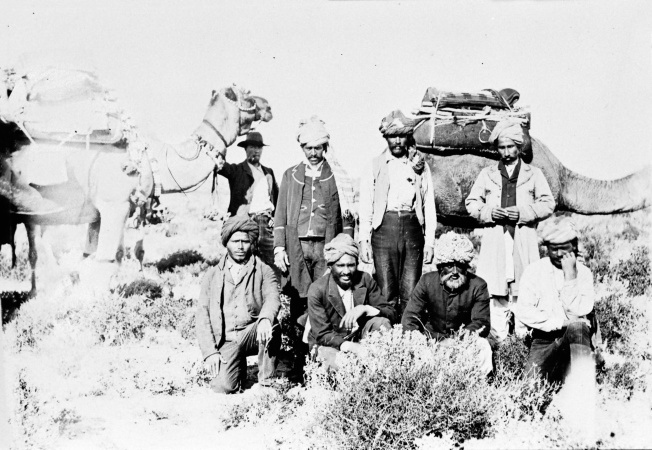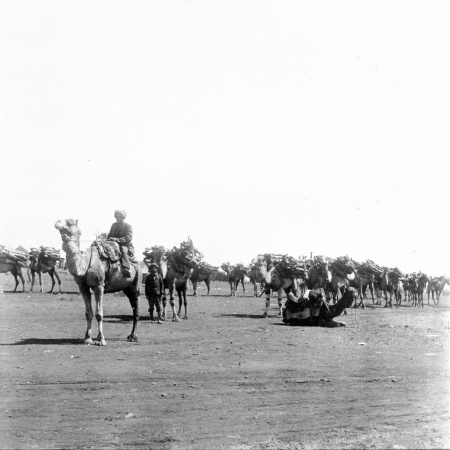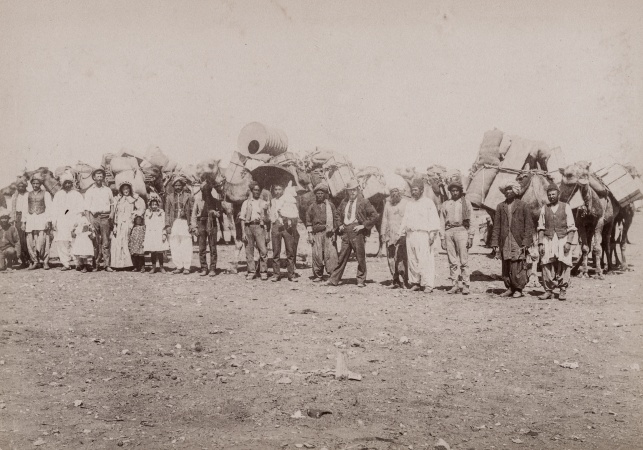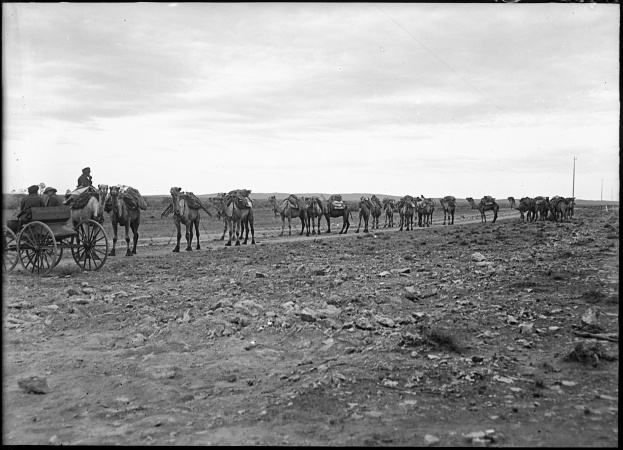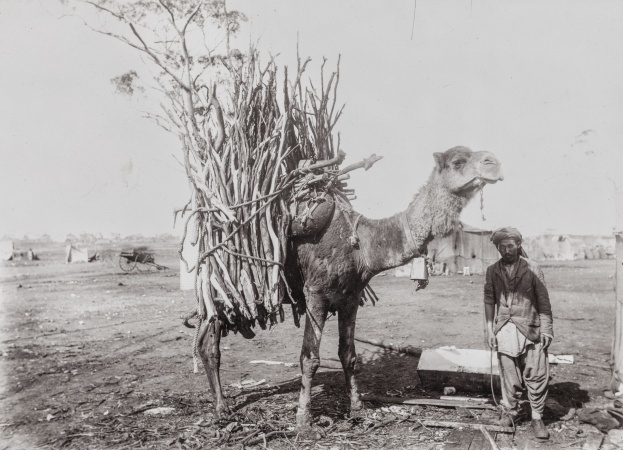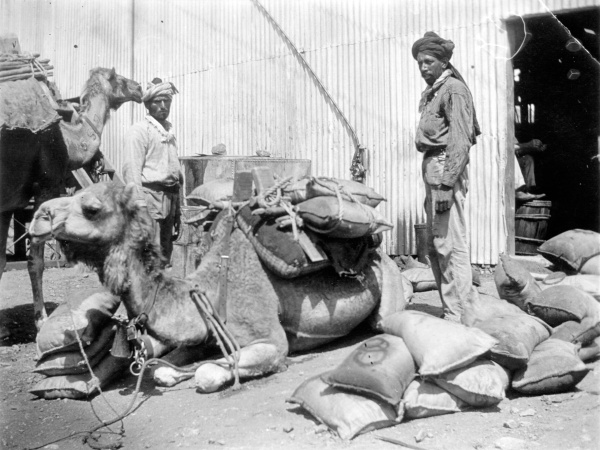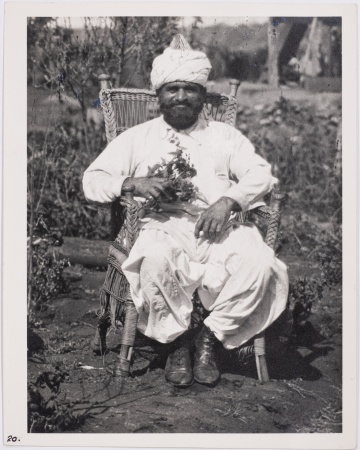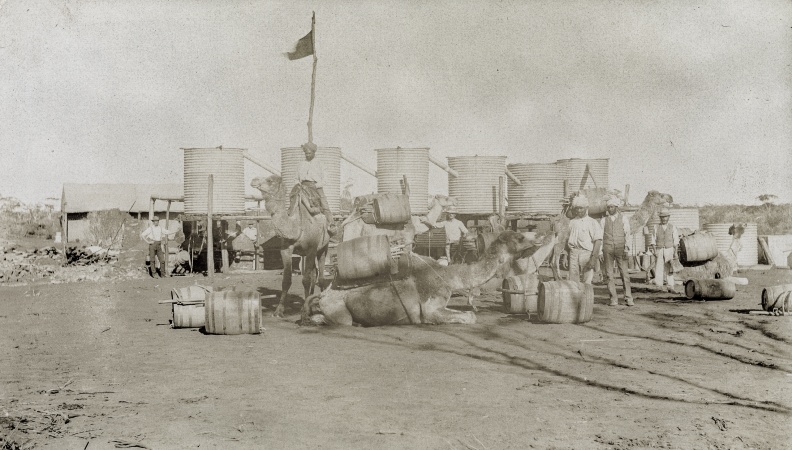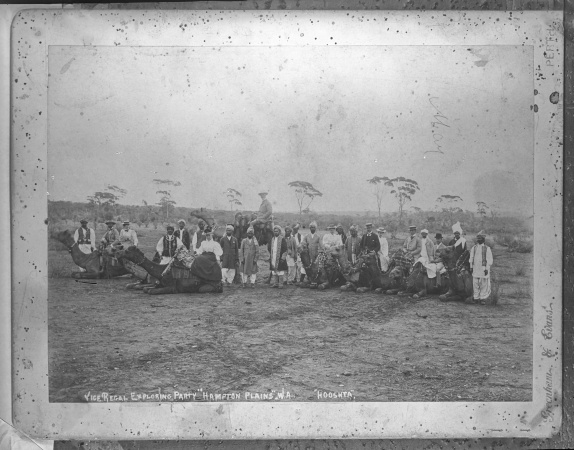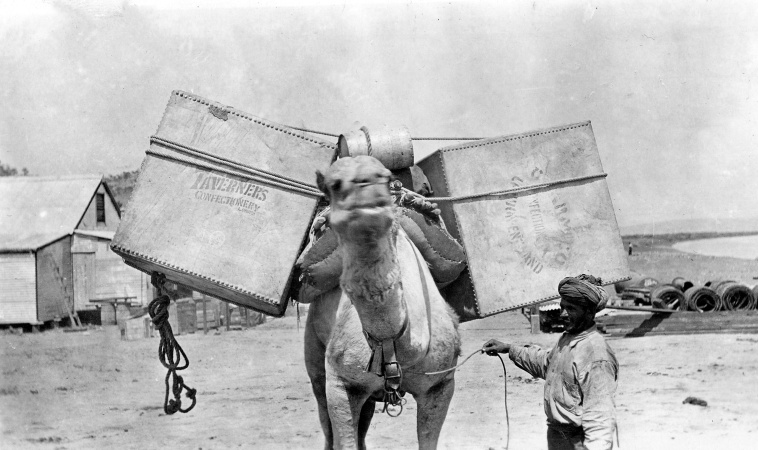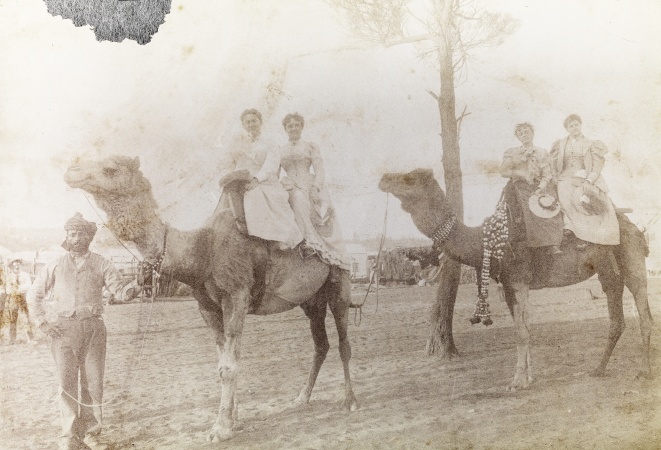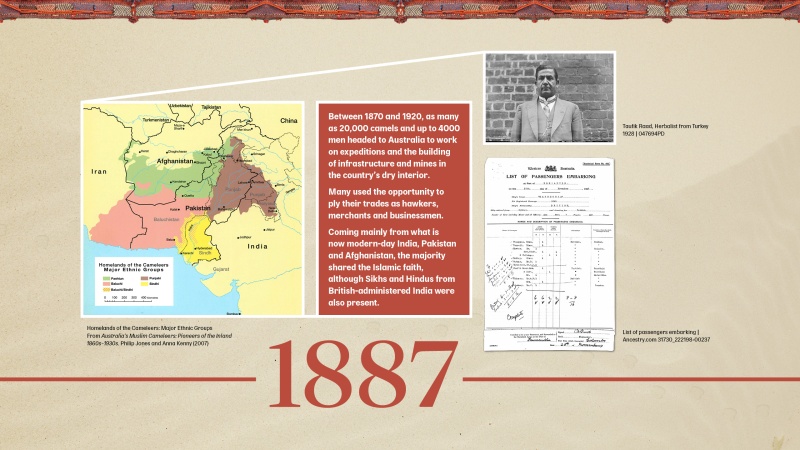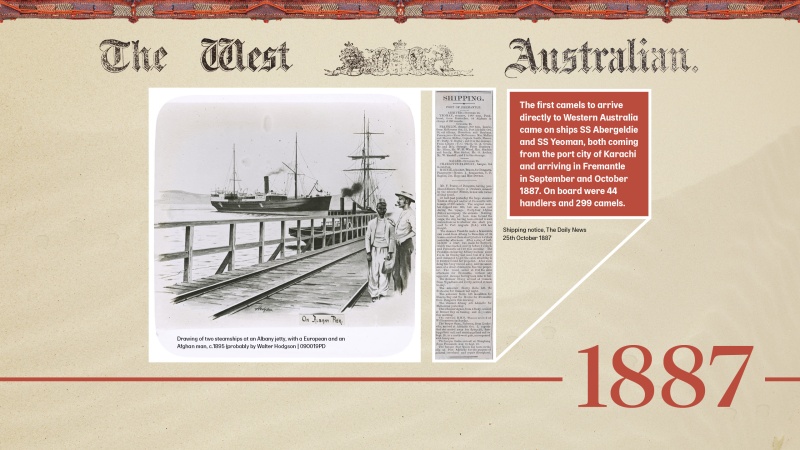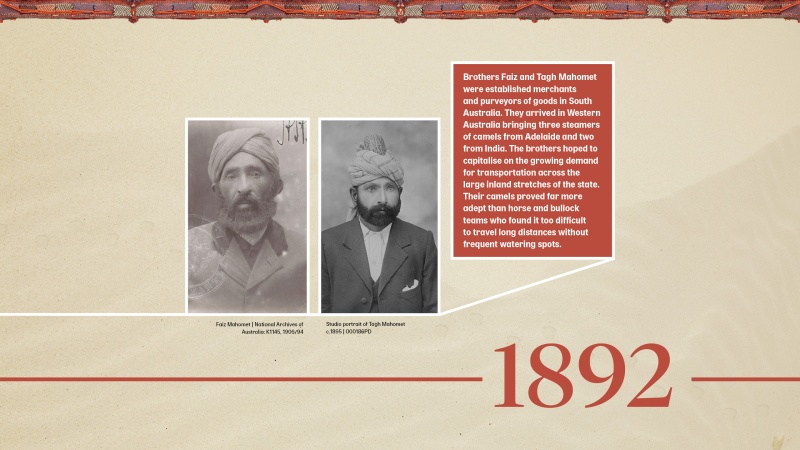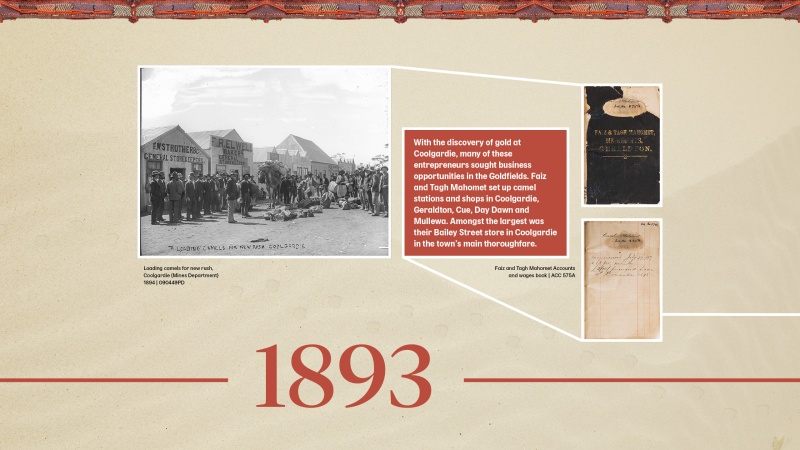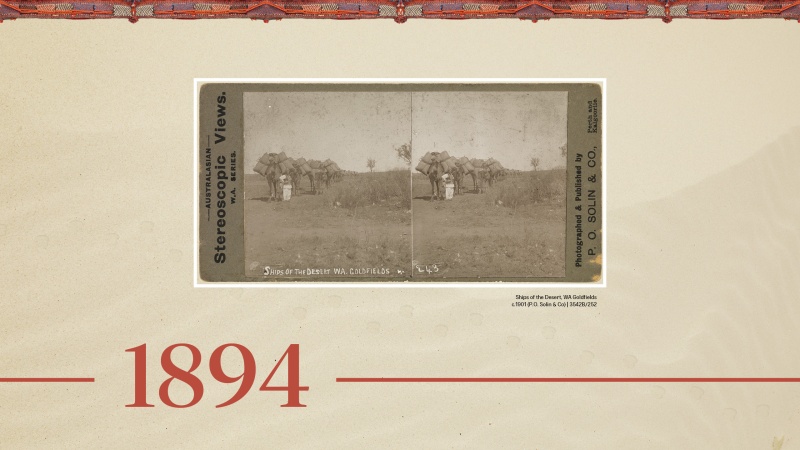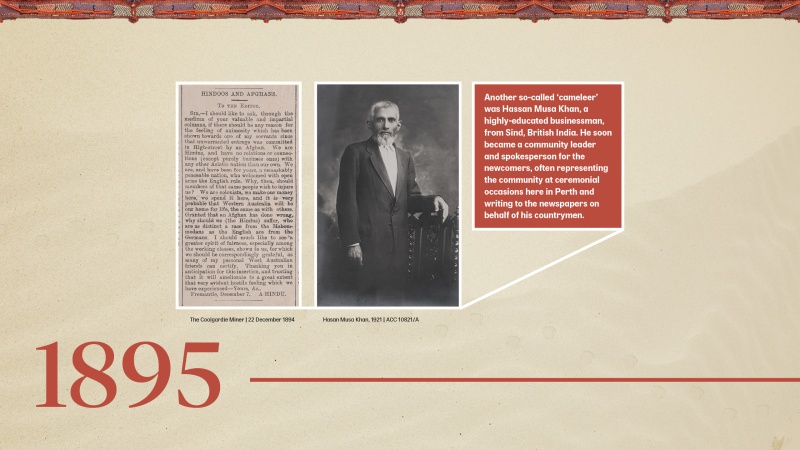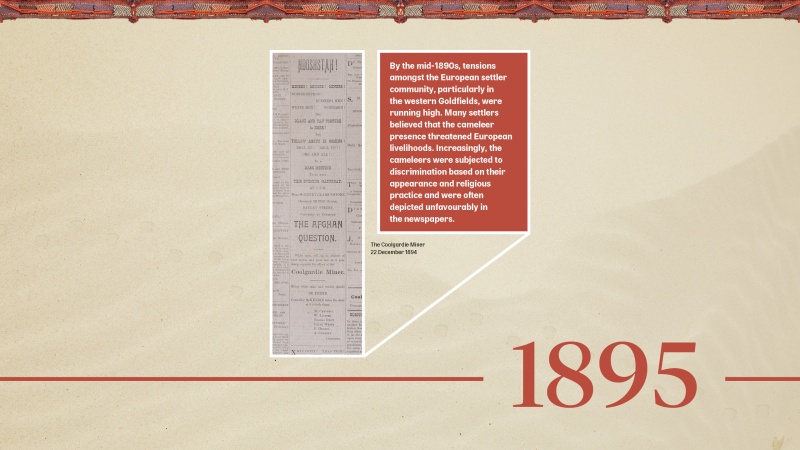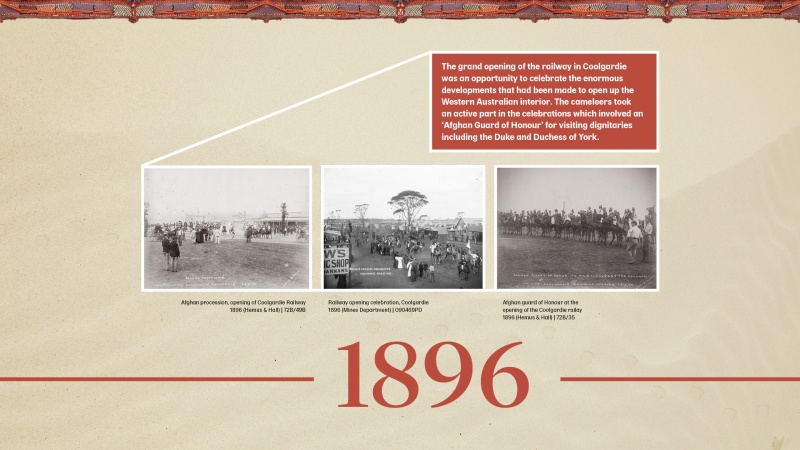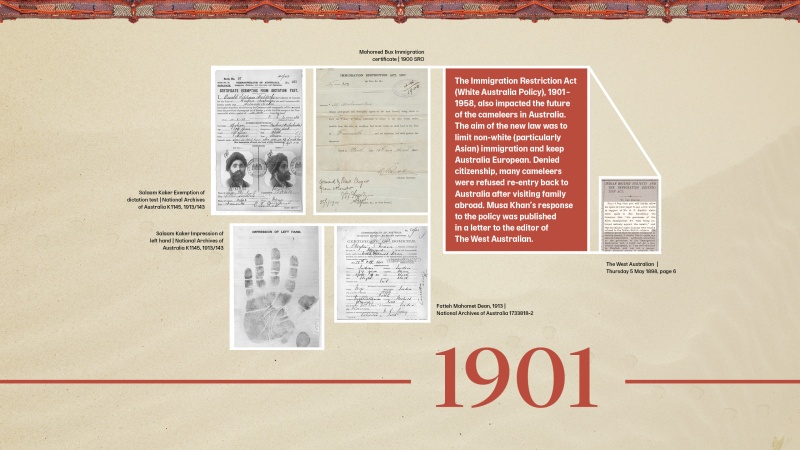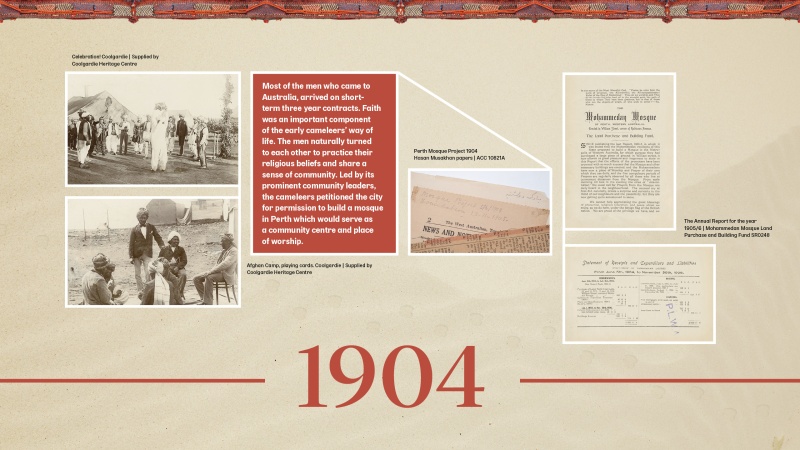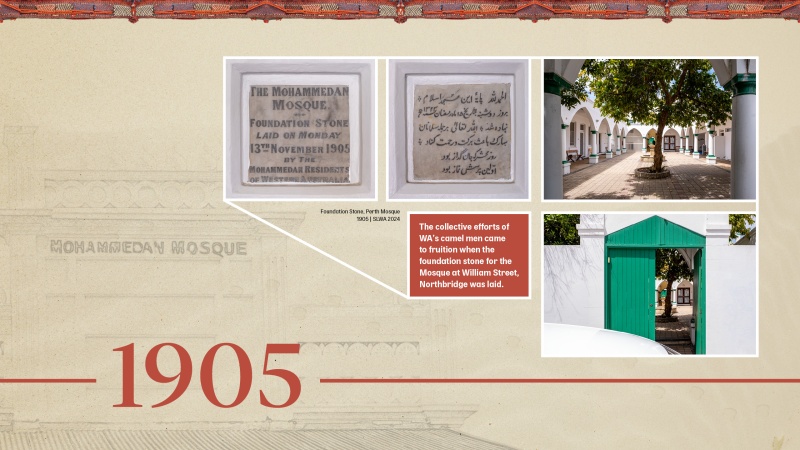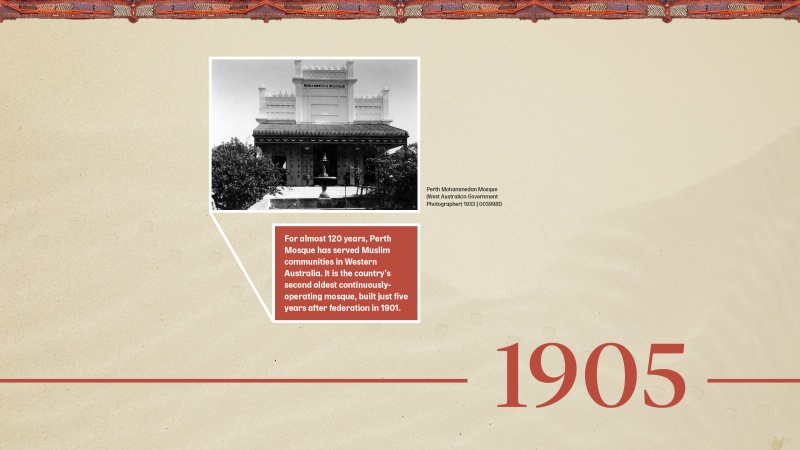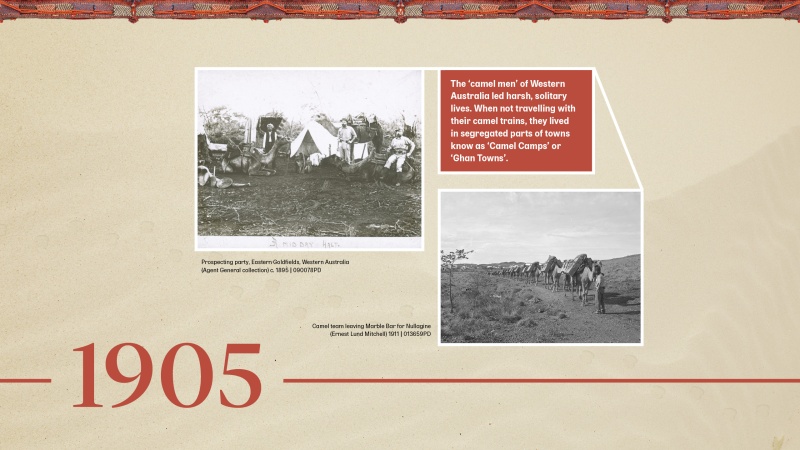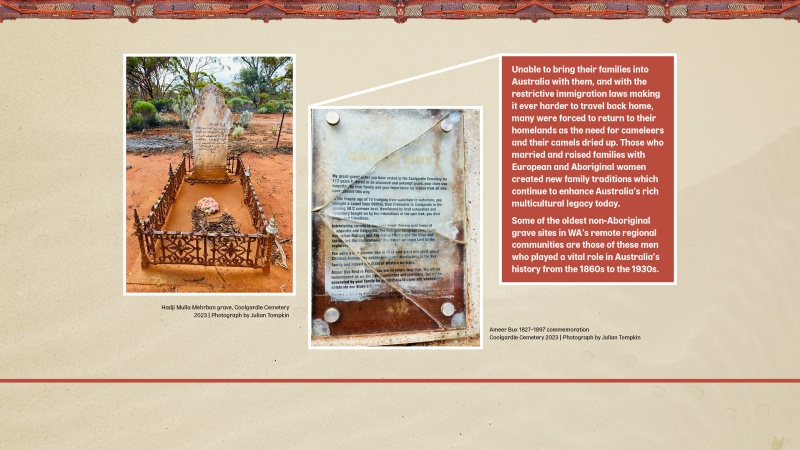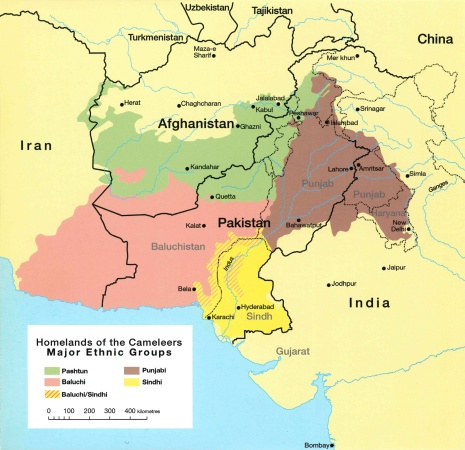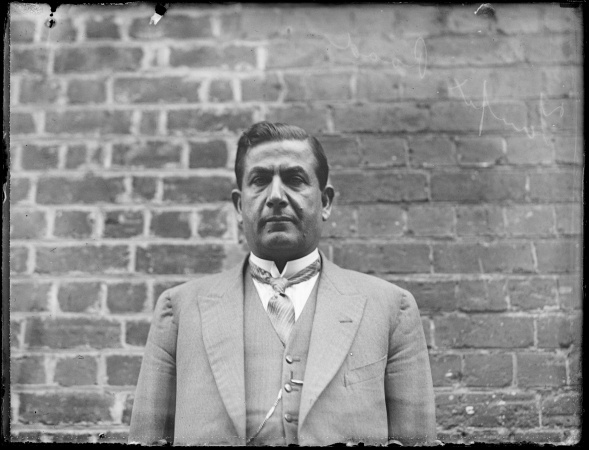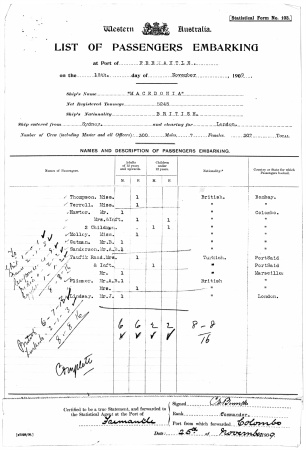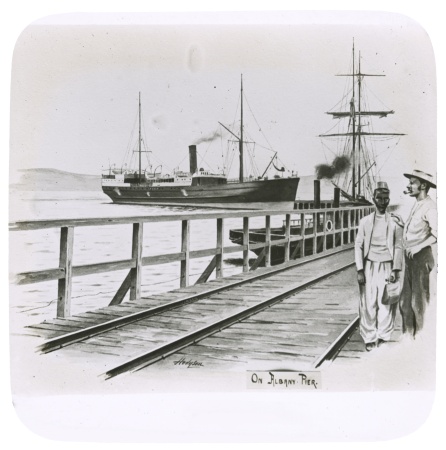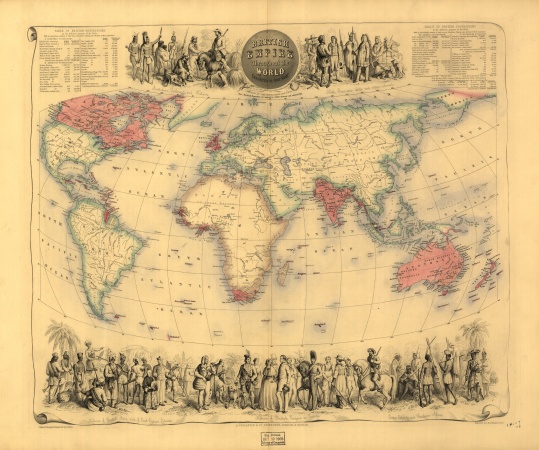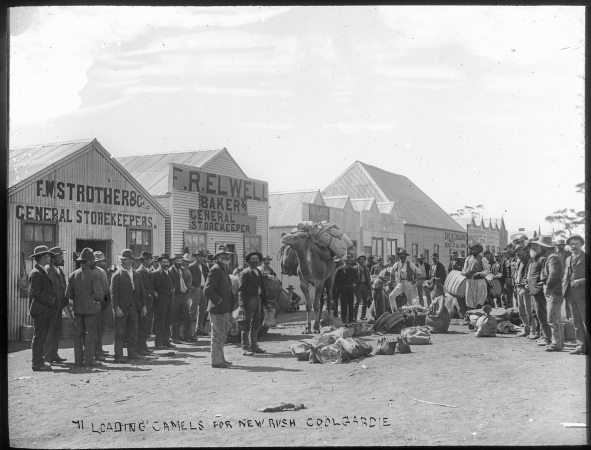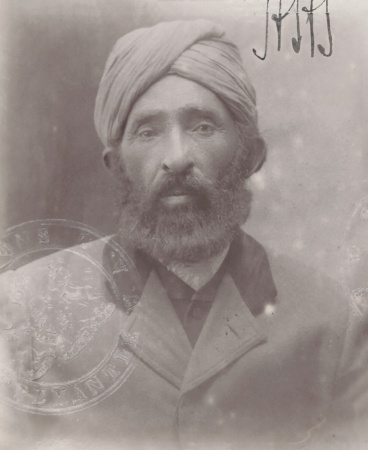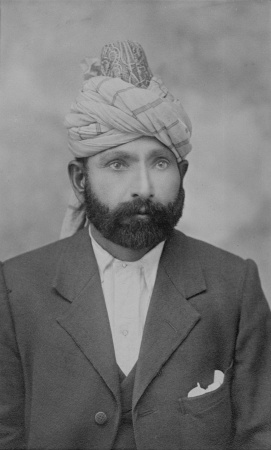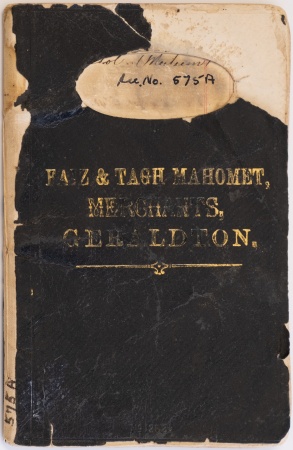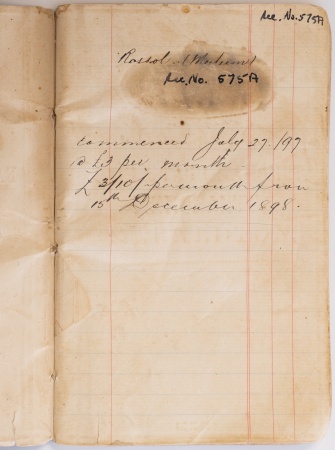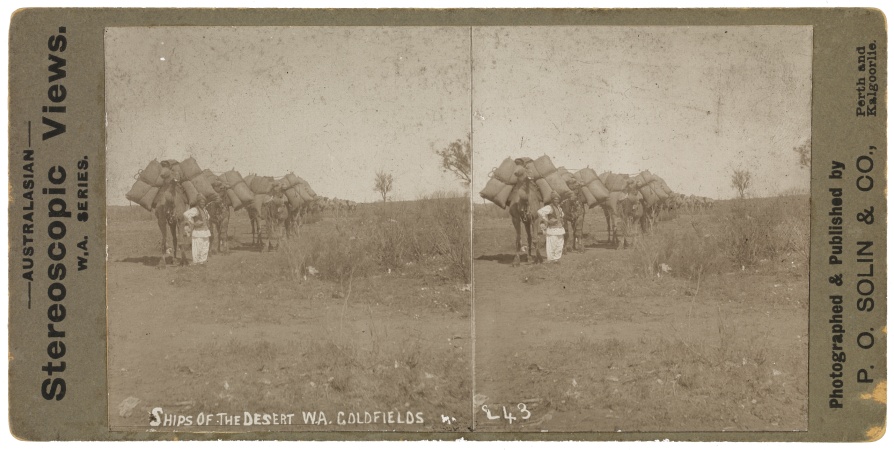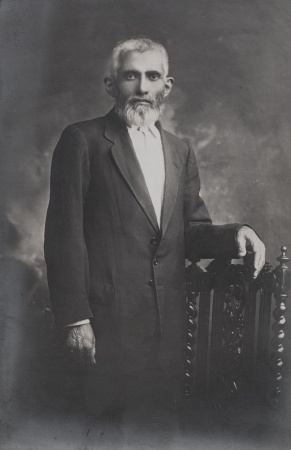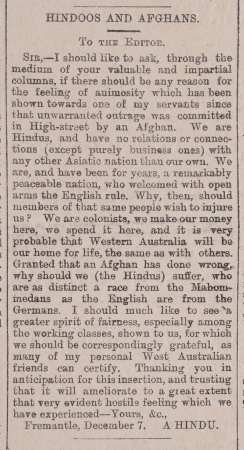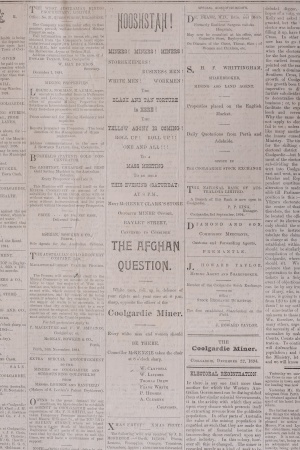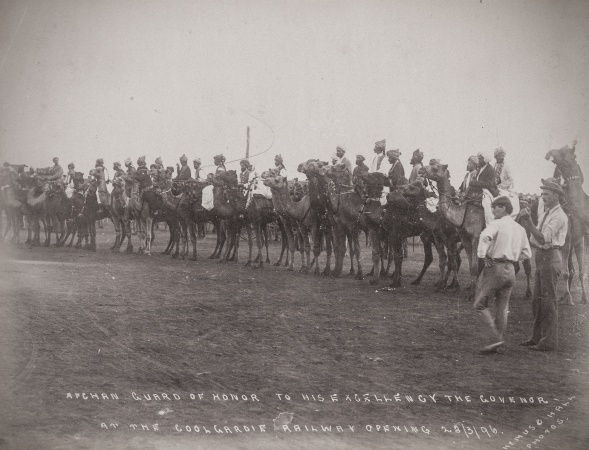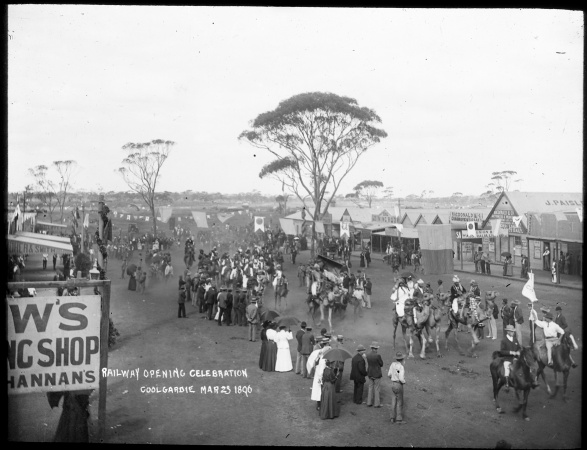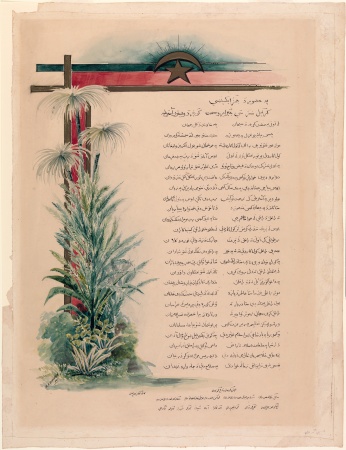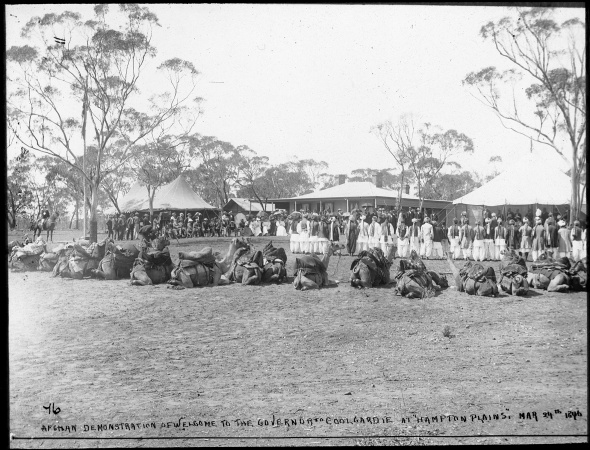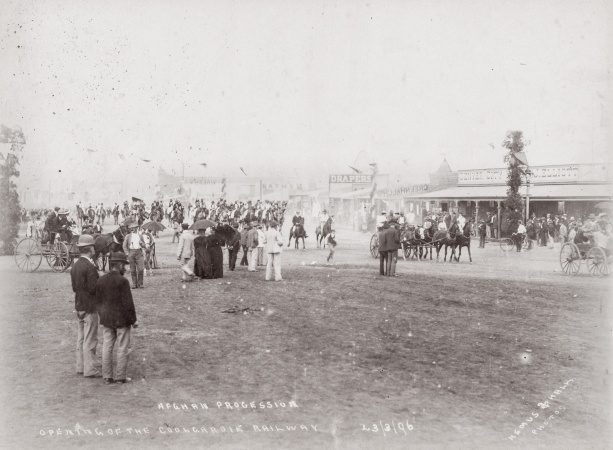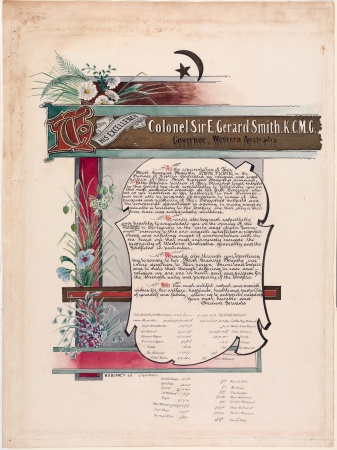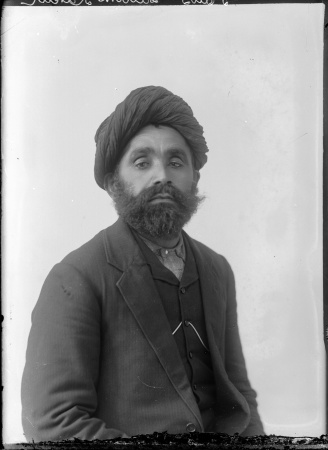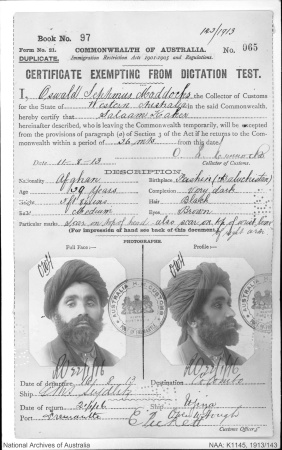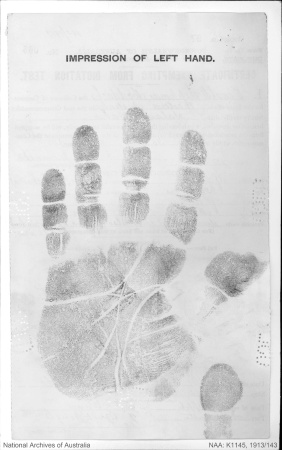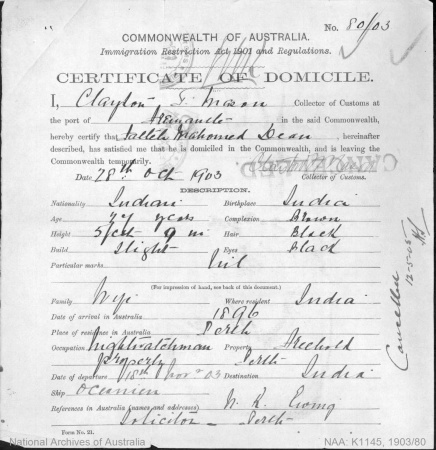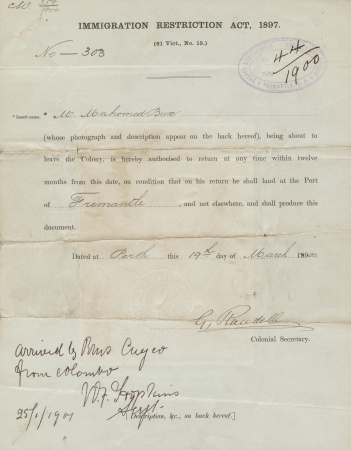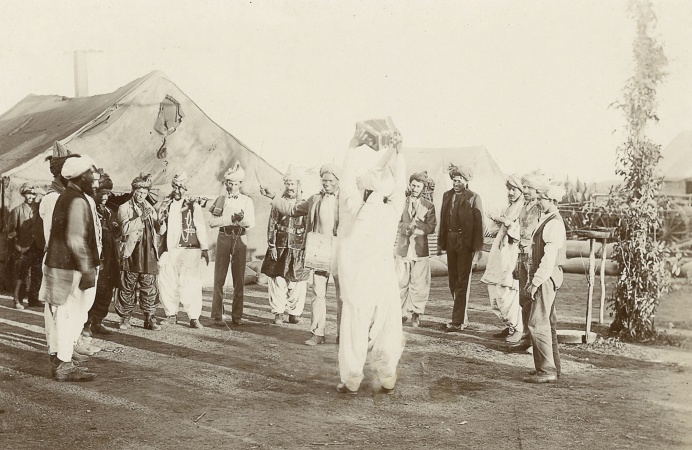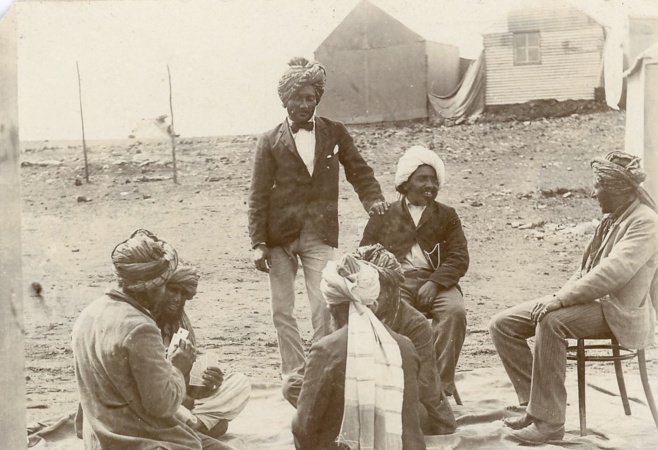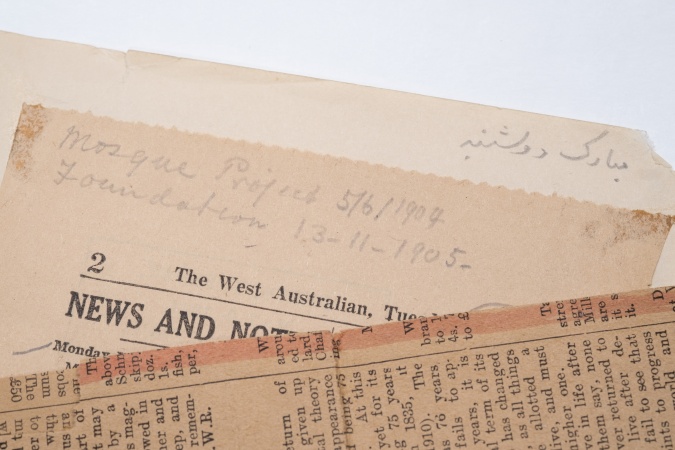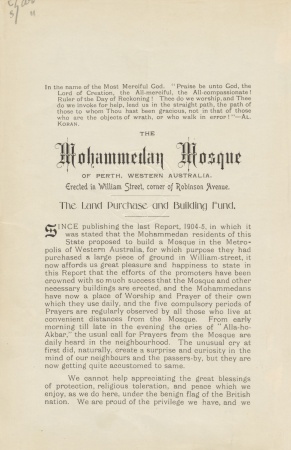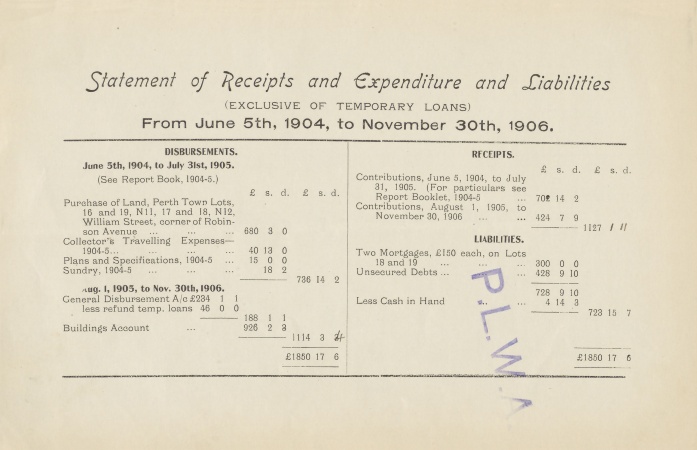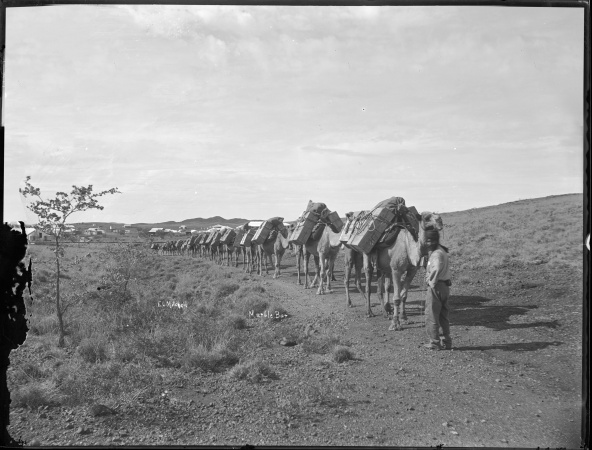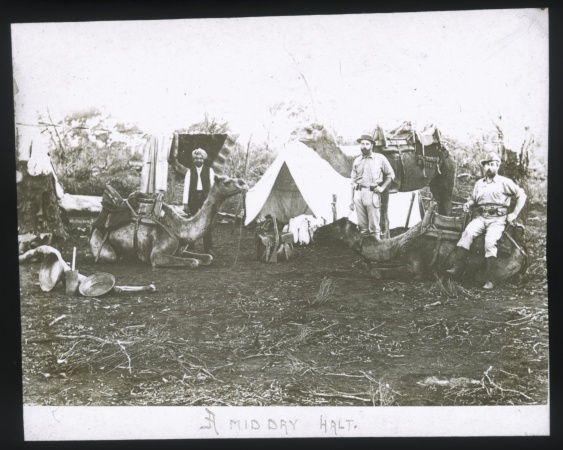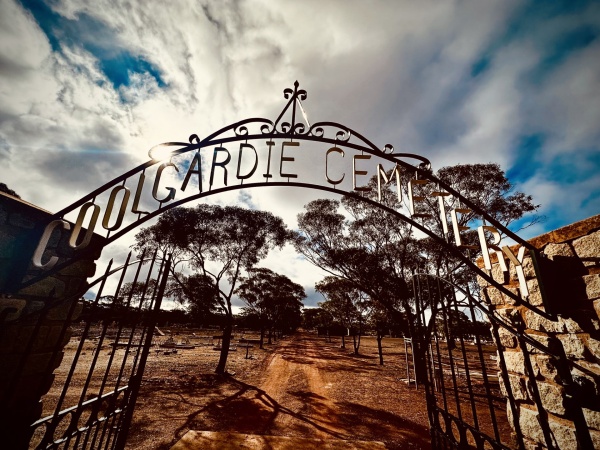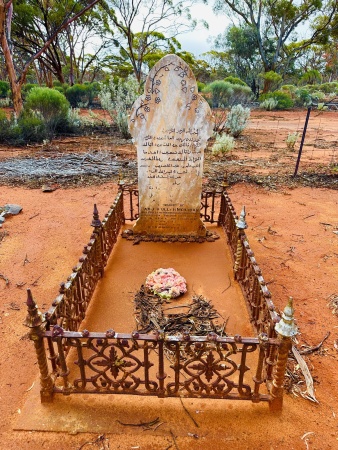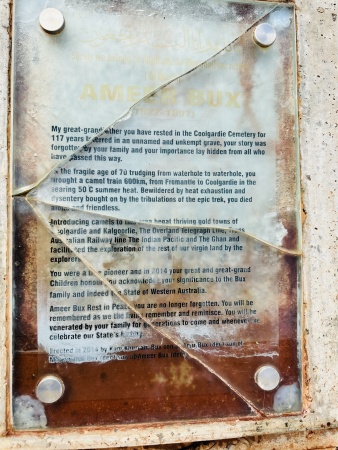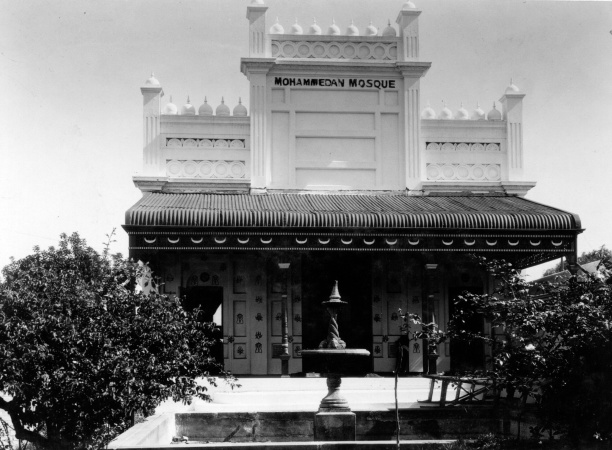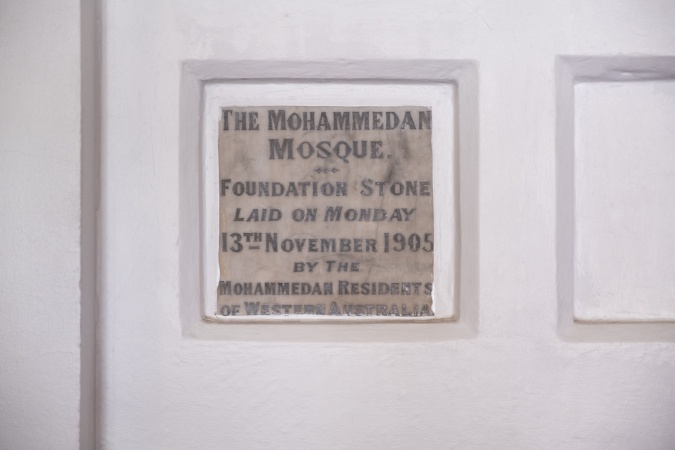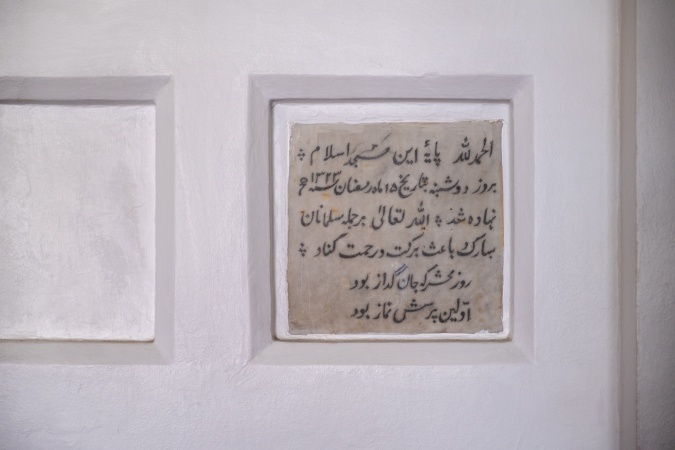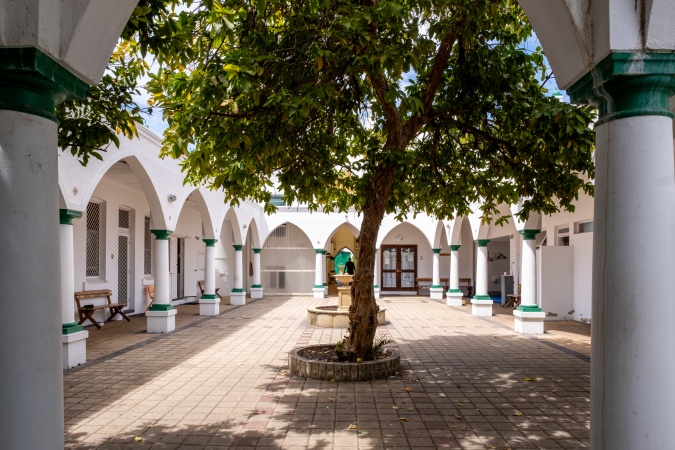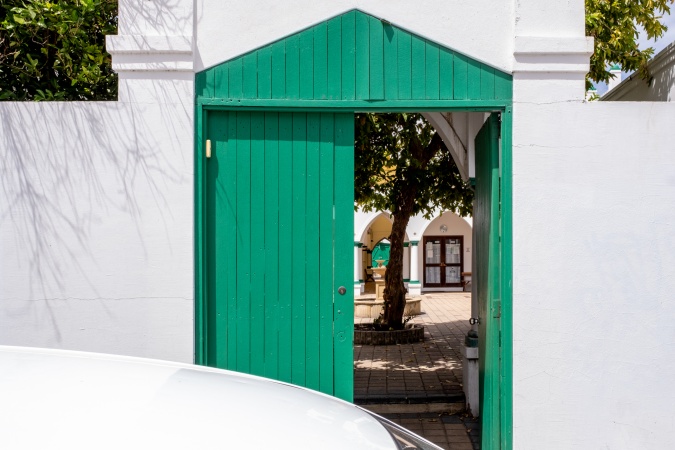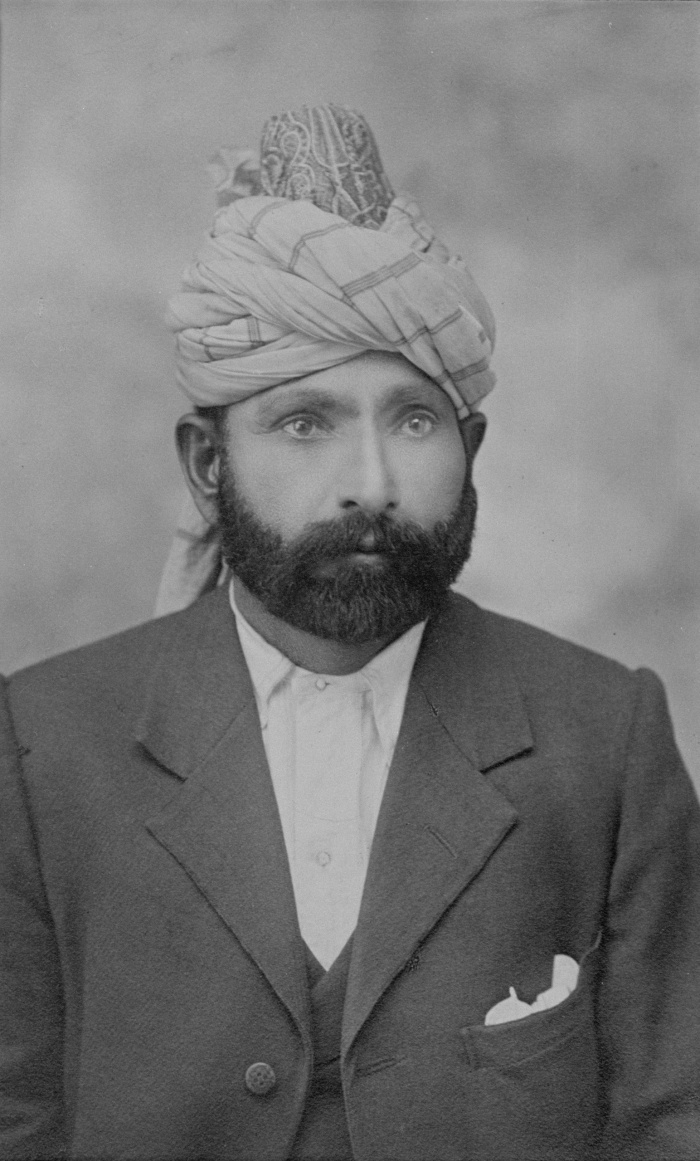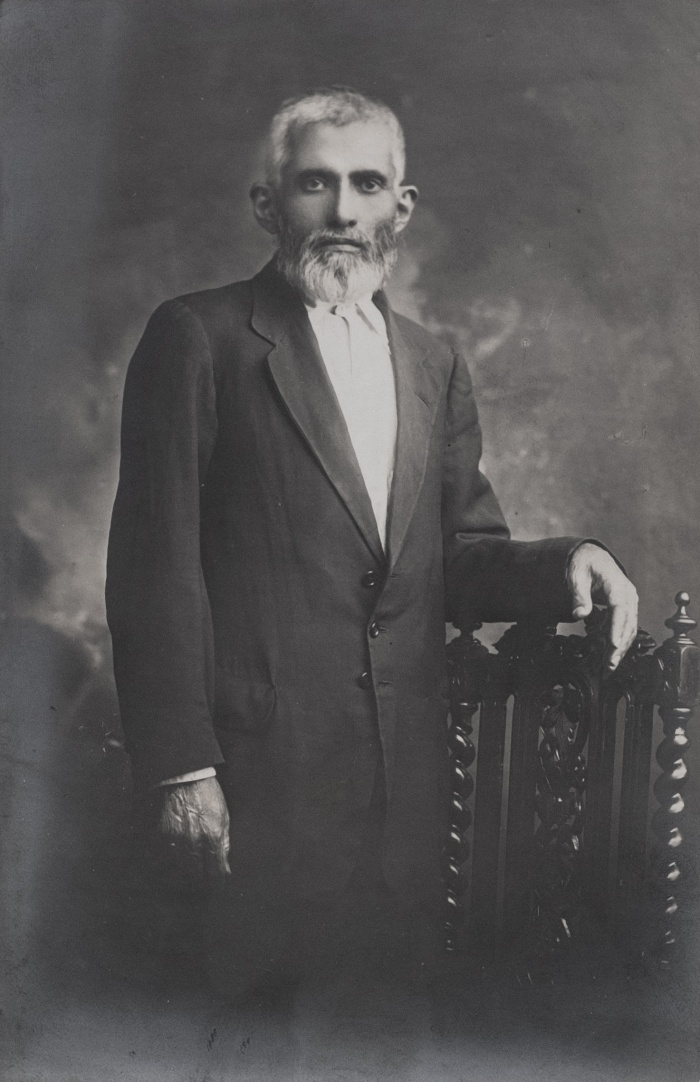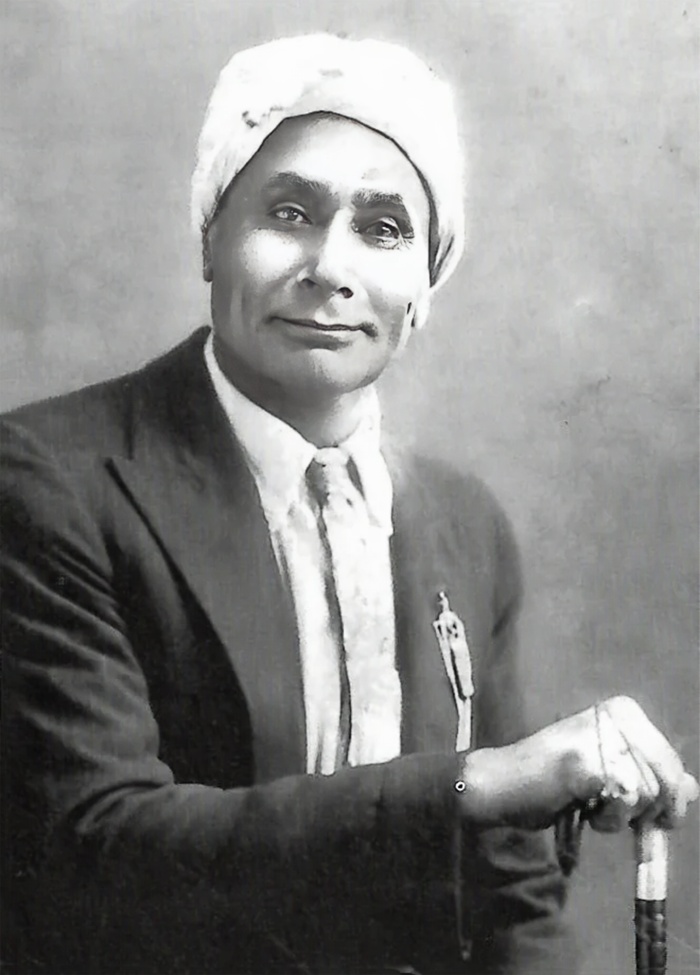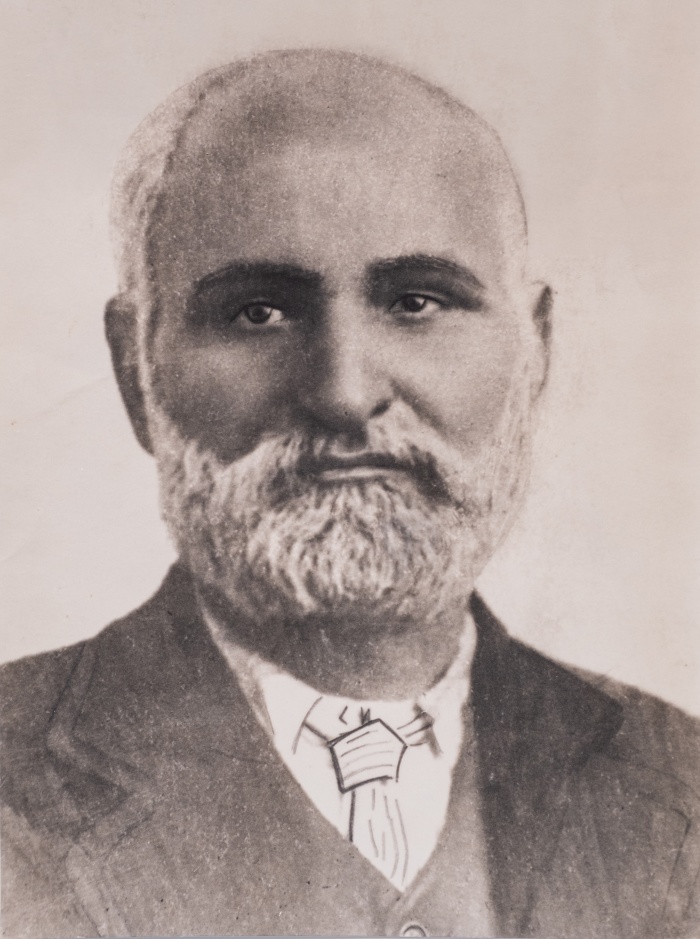
Sheiks, Fakes and Cameleers was exhibited at the State Library of Western Australia from 5 March to 7 October 2024. Discover the forgotten history of cameleers in Western Australia in our online version. Between 1870 and 1920, around 20,000 camels and 4,000 men travelled to Australia to help explore and develop the country's arid interior. Often referred to as "Afghan Cameleers", they came from diverse nationalities. Despite their important role, they were subjected to discrimination and hostility.
Visitors are warned that some words and descriptions in this exhibition may be culturally sensitive and might not normally be used in certain public or community contexts. Offensive and inappropriate terms and annotations reflect the attitude of the author or the period in which the item was written. Viewers are advised that this display may contain certain images, voices and videos of deceased persons, including Aboriginal and Torres Strait Islander Elders.
Virtual tour
Come inside and take a virtual tour of the Sheiks, Fakes and Cameleers exhibition. You can experience a portion of the exhibition in the online tour below. Use the arrows to navigate around the space and press the teal dots to learn more about each piece.
Scroll on to read more content from the exhibition further down.
Who were the Cameleers?
More than 150 years ago, camels and the men who cared for them were a familiar sight along the tracks connecting Australia’s outback to its coastal settler colonies. Often referred to as the ‘Afghan cameleers’, this incredibly diverse community, their stories and nationalities have at times been simplified into ‘fake’ stereotypes. This online exhibition aims to unpick their varied experiences and identities.
Cameleers transported supplies from cities to regional towns, inland mines and stations. They located water sources, helped build the country’s rail and telegraph services, worked as expedition guides and ensured a safe journey for travellers. In addition to their hard and slow work inland, many of these men left a lasting legacy on Western Australia’s social and economic landscape, which continues to resonate today.
Known only as ‘Cameleers’, ‘Afghans’ or simply ‘Ghans’, who were these men and what was their life like once they got here? Take a look through the passage of time to find out.
Timeline
1887
Between 1870 and 1920, as many as 20,000 camels and up to 4000 men headed to Australia to work on expeditions and the building of infrastructure and mines in the country’s dry interior. Many used the opportunity to ply their trades as hawkers, merchants and businessmen.
Coming mainly from what is now modern-day India, Pakistan and Afghanistan, the majority shared the Islamic faith, although Sikhs and Hindus from British-administered India were also present.
The first camels to arrive directly to Western Australia came on ships SS Abergeldie and SS Yeoman, both coming from the port city of Karachi and arriving in Fremantle in September and October 1887. On board were 44 handlers and 299 camels.
Eager crowds flocked to Fremantle port to witness the animals being winched ashore and to gaze curiously at their handlers. These were men who came mainly from the north-west frontier provinces of British-administered India, Afghanistan and what is now Pakistan. A smaller number came from countries where Britain had strategic interests such as Egypt, Turkey (now Turkiye), Iran and Syria.
1892-93
Brothers Faiz and Tagh Mahomet were established merchants and purveyors of goods in South Australia. They arrived in Western Australia bringing three steamers of camels from Adelaide and two from India. The brothers hoped to capitalise on the growing demand for transportation across the large inland stretches of the state. Their camels proved far more adept than horse and bullock teams who found it too difficult to travel long distances without frequent watering spots.
With the discovery of gold at Coolgardie, many of these entrepreneurs sought business opportunities in the Goldfields. Faiz and Tagh Mahomet set up camel stations and shops in Coolgardie, Geraldton, Cue, Day Dawn and Mullewa. Amongst the largest was their Bailey Street store in Coolgardie in the town’s main thoroughfare.
1894-95
Another so-called ‘cameleer’ was Hassan Musa Khan, a highly-educated businessman, from Sind, British India. He soon became a community leader and spokesperson for the newcomers, often representing the community at ceremonial occasions here in Perth and writing to the newspapers on behalf of his countrymen.
By the mid-1890s, tensions amongst the European settler community, particularly in the western Goldfields, were running high. Many settlers believed that the cameleer presence threatened European livelihoods. Increasingly, the cameleers were subjected to discrimination and hostility based on their appearance and religious practices. Despite their important role in the economic expansion of Western Australia, they were often depicted unfavourably in the newspapers. In the gallery below, this selection of newspaper clippings gives a window into how cameleers were perceived by the communities they worked with.
These newspaper extracts are courtesy of Trove, a National Library of Australia-led digitisation project. You can read thousands of pre-1954 newspapers in an accessible, easy to read, format at trove.nla.gov.au
1896
The grand opening of the railway in Coolgardie was an opportunity to celebrate the enormous developments that had been made to open up the Western Australian interior. The cameleers took an active part in the celebrations which involved an ‘Afghan Guard of Honour’ for visiting dignitaries including the Duke and Duchess of York.
1901
The Immigration Restriction Act (White Australia Policy), 1901–1958, also impacted the future of the cameleers in Australia. The aim of the new law was to limit non-white (particularly Asian) immigration and keep Australia European. Denied citizenship, many cameleers were refused re-entry back to Australia after visiting family abroad. Musa Khan’s response to the policy was published in a letter to the editor of The West Australian.
1904
Most of the men who came to Australia, arrived on short-term three year contracts. Faith was an important component of the early cameleers’ way of life. The men naturally turned to each other to practice their religious beliefs and share a sense of community. Led by its prominent community leaders, the cameleers petitioned the city for permission to build a mosque in Perth which would serve as a community centre and place of worship.
1905 onwards
The ‘camel men’ of Western Australia led harsh, solitary lives. When not travelling with their camel trains, they lived in segregated parts of towns know as ‘Camel Camps’ or ‘Ghan Towns’.
Unable to bring their families into Australia with them, and with the restrictive immigration laws making it ever harder to travel back home, many were forced to return to their homelands as the need for cameleers and their camels dried up. Those who married and raised families with European and Aboriginal women created new family traditions which continue to enhance Australia’s rich multicultural legacy today.
Some of the oldest non-Aboriginal grave sites in WA’s remote regional communities are those of these men who played a vital role in Australia’s history from the 1860s to the 1930s.
The collective efforts of WA’s camel men came to fruition when the foundation stone for the Mosque at William Street, Northbridge was laid.
For almost 120 years, Perth Mosque has served Muslim communities in Western Australia. It is the country’s second oldest continuously-operating mosque, built just five years after federation in 1901.
Forgotten Histories
The cameleers came from all parts of the former British Empire but were often lumped in as one generic group. Their stories reveal their diverse skills and contributions.
The Mahomet Brothers
Faiz and Tagh Mahomet were Afghan brothers who were related to the Amir of Afghanistan through marriage. They worked for Thomas Elder’s pastoral company in South Australia prior to starting their own camel transport and haulage business. They moved to Western Australia’s Goldfields with the 1890s gold rush. By 1892, the brothers had set up camel stations and stores across the Goldfields and as far north as Geraldton. They were awarded government contracts to supply the construction teams building railways and the overland telegraph that connected the remote West Australian interior to the outside world.
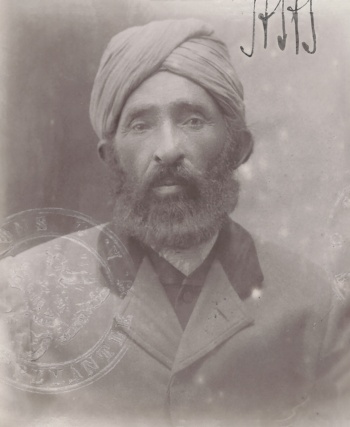
The brothers’ partnership ended suddenly in 1896 when Faiz’s younger brother Tagh was shot dead while at prayer in Coolgardie. His assailant, former business partner Goulam Mahomet, was later hanged for the murder at Fremantle Prison.
Faiz continued to run his business despite the government’s increasingly restrictive practices towards Asian-owned business. A faithful Muslim, Faiz Mahomet travelled across Western Australia to seek donations for the construction of the Perth Mosque. On 13 November 1905, Faiz laid the Mosque’s foundation stone. He later returned to India, where he died in 1910. A commemorative plaque for Faiz and Tagh Mahomet is located on St Georges Terrace, recognising their contribution to the development of Western Australia in the 1890s.
Hasan Musa Khan
Born to a wealthy trading family in Karachi, Hasan Musa Khan’s links to Australia trace back to his uncle Khan Bahadur Moradkhan who was the first South Asian supplier of camels to Australia.
In 1893, Khan travelled to South Australia to work as a clerk for businessmen Faiz and Tagh Mahomet before travelling to Western Australia to help oversee the Mahomet brothers’ camel haulage and supply venture in the eastern Goldfields.
Highly educated and fluent in several languages, Khan was known as a philosopher and man of letters and quickly became a prominent member of the early Australian Muslim community.
Khan married Sofia Blitz, a German Jewish woman in 1898 by special license at the Supreme Court in Perth. They had four children together and were quickly adopted as members of WA’s high society.
A prolific writer, Musa Khan often spoke out about the unfair treatment of his countrymen in Australia. He donated many books and pamphlets, including his co-edited booklet on the history of Islam in Australia, to the State Library’s collection.
In 1904 Khan was instrumental in proposing the building of the Perth Mosque, which remains the second oldest continuously-functioning mosque in Australia.
Goolam Badoola
Family legend has it that in his late teens, Goolam Badoola was at the port in Karachi with his two camels when another camel broke away from its handler. Badoola re-captured the animal and was rewarded for his efforts by being asked to join the group of cameleers en route to Australia. The voyage took three months and landed in Port Augusta, South Australia, where Badoola found work transporting goods across the inland tracks to settlers and miners.
When gold was found in Western Australia, Badoola headed west. It was here that Badoola - a cameleer from Baluchistan, then a province in the northwest of British India – became an Australian hero. When a flood gripped the areas around Geraldton in 1900, Badoola took his camels to rescue stranded victims at Cue who were at risk of starvation and drowning. He also brought in much needed water and food supplies. This act of heroism earned Badoola recognition from the WA government, who granted him Australian citizenship and a sum of money for his extraordinary effort.
Using the money to purchase a property in Mount Magnet, Badoola became one of a select number of cameleers to own land and be granted citizenship rights. In his forties Badoola married Mariam Martin who was the daughter of a Malay Muslim man and a Yamatji woman of the Badimaya people from the Murchison Gascoyne (Mount Magnet). They had four children before Mariam died in childbirth in 1929. Today, proud of their family heritage, the Rinds are a prominent Baluchi/Aboriginal WA family.
Khwaja Muhammad Bux
Known as “the Sinbad of Lahore” Muhammed Bux was born into a family of Kashmiri silk traders in 1857 in what was then Lahore, India. Escaping an unhappy childhood whilst still in his teens, Bux started a life of seafaring adventure working on British ships profiting from colonial expansion into lucrative Indian Ocean trading routes. It was during one of these voyages that he heard from an Englishman about Australia, the “land of the gold mines”.
Bux’s first voyage to Australian shores brought him to Melbourne in 1885. On a return trip he landed in Fremantle with little more than the clothes on his back. His entrepreneurial spirit soon saw him go from a travelling hawker to a shop-owner, before building a thriving import and export business. Living simply above a shop, first with his father and later with his wife and daughter, Bux set about acquiring several buildings and businesses in Perth and contributed to the camel trade by bringing in shipments of camels.
By 1898, his nose for business saw The West Australian newspaper describe him as a “leading man among the Asiatic residents of the city”. A philanthropist, Bux recognised the need for WA’s Muslim community to have a place of worship and helped finance Perth Mosque. In Lahore, he established a Mosque next to the family home which is called ‘Australia House’ and built a girls’ school in an area known as ‘Australia Chowk’ or ‘Australia Bazaar’. Today in what is modern-day Pakistan, his family are known as the ‘Australia-wallahs’ who can trace their family back seven generations to their ties with Australia.
Walking Trail
Continue the journey by downloading this self-guided walking trail through Perth and Northbridge. Follow in the footsteps of the cameleers of Western Australia.
Discover more
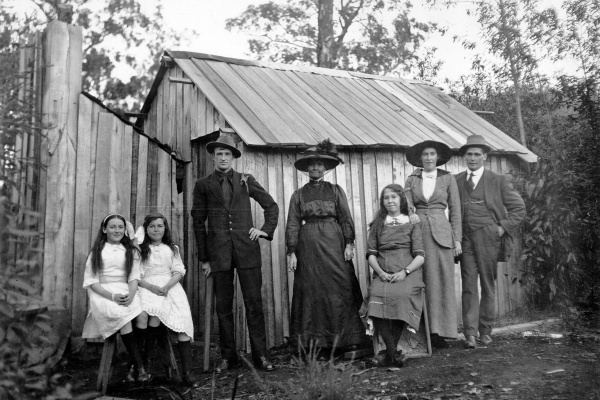
WA Migration Stories
This education resource is an introduction to Western Australia’s migration history which aims to support classroom learning relating to the movement of people to WA including the cameleers.


